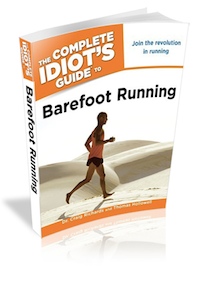The good folks at barefoot-running.us sent me a copy of The Complete Idiot’s Guide to Barefoot Running by Dr. Craig Richards and Thomas Hollowell to review here on Strength Running and I must say… I am pleasantly surprised. I’m usually skeptical of these books and consider them too basic and not very thorough.
I was wrong – this book delivers!
More than just a book, The Complete Idiot’s Guide to Barefoot Running is like an encyclopedia of barefoot running information. Its audience is beginners who want to learn more about running barefoot, but there are sections that even advanced barefoot runners will enjoy.
I’m impressed by the sheer breadth of information that’s included in the book. In addition to a focus on the basics like form and injury prevention, there is one chapter that deals specifically with barefoot periodization. I haven’t heard of periodization used in this context before, but it makes sense.
Periodizing your barefoot running allows you to gradually introduce your body to running without shoes. It helps you prevent injuries while maximizing the benefits of running barefoot. It includes six stages:
- Preparation – walking barefoot, strengthening exercises, and an introduction to barefoot running.
- Learning New Skills – focus on proper running form with drills and core work.
- Increasing Distance – running form is still a focus while gradually increasing the distance run barefoot.
- Increasing Intensity – faster running while decreasing distance and strengthening the hips, ankles, and feet.
- Peak Performance – for those who have a goal race they want to complete barefoot/in minimalist shoes.
- Rest and Recovery – complete rest or active recovery; a focus on rejuvenation and injury prevention.
Similar to any high-quality training plan, a periodized schedule for barefoot running can help with many of the problems that new minimalists face: injuries and raw feet. Nobody wants that.
Barefoot Running – The Big Picture
The Complete Idiot’s Guide to Barefoot Running covers several topics that aren’t necessarily unique to running without shoes. They have a great chapter on minimalist running shoes, profiling shoes and companies (a few that I haven’t heard of, like Skora Running) that you can use in the winter and during your transition to barefoot running.
The authors recognize that running barefoot isn’t practical or ideal in every circumstance. Minimalist running shoes can deliver many of the strength and efficiency benefits of barefoot running while protecting your feet from unforgiving surfaces and extreme weather.
A few companies that they rate – with a clever 1-10 “feet” rating system – include Terra Plana, Vibram, and Newton Running. I’m personally fascinated with the Terra Plana line of Evo running shoes because of their simplicity, design, and resemblance to training flats. Hopefully there will be a review coming soon.
MovNat is also discussed briefly – a system of natural training that focuses on basic movements around the mantra “explore your true nature.” Founder Erwan Le Corre has been dubbed “The World’s Fittest Man” and has put together an impressive collection of photos and videos based on this training. I’ve included one of these videos on an earlier motivation post. Attending a workshop to see the benefits for distance runners is a big goal of mine.
Trail running seems to go hand in hand with barefoot running as those who like to run without shoes are looking for a more “natural” experience. And of course, a complete trail running chapter is included that I found very useful. Topics like trail running form, types of trails, a trail runner’s “survival kit” (prevention and treatment of small injuries), and how to use GPS devices are detailed.
My favorite piece of advice in this section:
“Continuing to run on different kinds of trails will allow you to acclimate to a variety of surfaces… Calibrating your landing, controlling impact, and determining where to plant your foot before it hits the ground are important reflexive skills that will boost your trail-running confidence and ability immensely.”
Well put.
Should You Buy It?
If you’re new to barefoot running and want to learn more about it before starting, then absolutely. You should also check it out if you just want to keep a very handy book about minimalism around for future reference. It’s over 300 pages of advice on form, strength, training, periodization, shoes, and stretches in an easy-to-read format.
There are two subjects that I think should have been expanded. The most important is the chapter on injuries. It’s very short and only discusses the basic treatment advice that most runners already know: rest, ice, compression, elevation, etc. Considering injuries are common among beginning barefoot runners this should have been given more attention. Instead the focus is on prevention, which is great because it’s easier to prevent an injury than treat one, but I think a more thorough chapter is needed.
Barefoot racing is also covered, something I just can’t recommend for anybody who cares about how fast they run. It will likely takes years to run as fast or faster than you can in a lightweight racer (I use the Hyper Speeds) and the injury risk is far too high for me to recommend. Barefoot running can help you race faster when used in training as a tool, but from a performance perspective you should race in minimalist shoes.
Like I mentioned earlier, I’m really impressed with this book. Overall, it’s very thorough and can give you a huge advantage to your barefoot running. I don’t think everyone should start barefoot running and focus on it, but if that’s your goal then this is a good resource. If you’re interested, check out The Complete Idiot’s Guide to Barefoot Running on Amazon.